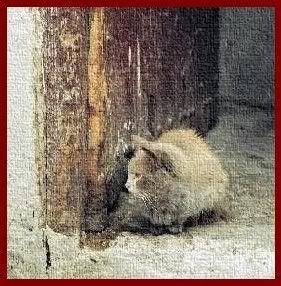A Cat in Meknès
 I like Meknès. There, I've said it. Out loud. Liking Meknès isn't a something I share with too many of my colleagues but I like it, so there it is. Its greatest advantage, of course, is the fact that it isn't Rabat. Based on that alone, I could easily move on to the peroration of this posting. Many of you will probably wish that I had.
I like Meknès. There, I've said it. Out loud. Liking Meknès isn't a something I share with too many of my colleagues but I like it, so there it is. Its greatest advantage, of course, is the fact that it isn't Rabat. Based on that alone, I could easily move on to the peroration of this posting. Many of you will probably wish that I had.Last Saturday, Mr. Cat in Rabat and I slipped away to the Alcohol & Murder Capital of Morocco for a weekend getaway - and by weekend, I mean one night. But it was one night in a lovely riad whose only fault lay in the fact that the muezzin from the nearby mosque chose to call the faithful from our bathroom. So except for having to peel me off the ceiling at the first intonation of Allahu akbar, it was fabby.
Meknès has much to recommend it. It has *relatively* cheap beer, Vache Qui Rit Rouge cheese
But unlike any other Moroccan city, Meknès is irrevocably associated with the larger-than-life historical
To make manifest his vision of a bigger & better imperial city, Moulay Ismail "engaged" the services of tens of thousands of slaves - many of whom were Christian men, women, and children from Western Europe (notably the UK, Spain & Portugal) as well as the Mediterranean rim - who had been captured from ships, plucked from their Sunday church pews, or snatched from their homes by marauding Corsair pirates (or "Sally Rovers" from the erstwhile infamous Salé, Rabat's twin sister) and then sold to the Sultan. It is estimated that at any one time, there were at least 25,000 slaves labouring in Meknès. Considering that the Sultan cast his shadow on this planet for over 80 years, that makes for a considerably large hive of
These slaves suffered grievously, living and working under loathsome and tortuous conditions. To add to their long list of indignities, they were also used as pawns by Moulay Ismail during the on-again/off-again negotiations instigated by those Western leaders and clergy who toiled for their release. Not surprisingly, treaties were seldom honoured by the Sultan and it was not uncommon for slaves not to be released after ransoms were paid. Reneging on his promises with foreign ambassadors appears not to have troubled the Sultan's sleep any.
It is no exaggeration to say that the Sultan treated the 12,000-odd horses in his vast royal stables with greater concern and humanity than he did his workers; in fact, the urine from those horses which had completed the hajj to Mecca was caught in a special bowl by an await
 ing attendant, lest the undeserving earth below sully the sacred stream of piss. During one of my many past incarnations, that was my job.
ing attendant, lest the undeserving earth below sully the sacred stream of piss. During one of my many past incarnations, that was my job.Nonetheless, Moulay Ismail was a man of unwavering faith and was genuinely and profoundly concerned about the immortal souls of his infidel slaves. Consequently, many Christian slaves endured prolonged tortures - often by bastinado - honeyed with empty promises of better treatment and freedom if they converted to Islam. Often, those who refused to abjure their faith were publicly circumcised
Western historians consider Moulay Ismail a capricious and monstrous psychopath while many of their counterparts in North Africa revere him as the founder of modern Morocco. In fact, so important a historical figure is he that infidels like me can gain access to his mausoleum (photo, above right). But let me just add that cutting a man in half - vertically, from head to crotch - was a common method of execution under the Sultan, so you be the judge. Although, to be fair, he did consider it more humane to begin cutting from the head rather than from the nether regions.
So there you are. The Royal City of Meknès,








3 Comments:
Sounds delightful. Morocco, a land to explore and enjoy to the fullest.
Thanks for the historical note. Christian slaves - who knew?
Maybe he was still pissed about that whole "Crusade" thingie...
you have very nice blog
in fact i liked it very much
Post a Comment
<< Home